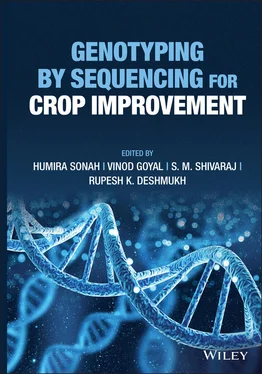Genotyping by Sequencing for Crop Improvement
Здесь есть возможность читать онлайн «Genotyping by Sequencing for Crop Improvement» — ознакомительный отрывок электронной книги совершенно бесплатно, а после прочтения отрывка купить полную версию. В некоторых случаях можно слушать аудио, скачать через торрент в формате fb2 и присутствует краткое содержание. Жанр: unrecognised, на английском языке. Описание произведения, (предисловие) а так же отзывы посетителей доступны на портале библиотеки ЛибКат.
- Название:Genotyping by Sequencing for Crop Improvement
- Автор:
- Жанр:
- Год:неизвестен
- ISBN:нет данных
- Рейтинг книги:4 / 5. Голосов: 1
-
Избранное:Добавить в избранное
- Отзывы:
-
Ваша оценка:
- 80
- 1
- 2
- 3
- 4
- 5
Genotyping by Sequencing for Crop Improvement: краткое содержание, описание и аннотация
Предлагаем к чтению аннотацию, описание, краткое содержание или предисловие (зависит от того, что написал сам автор книги «Genotyping by Sequencing for Crop Improvement»). Если вы не нашли необходимую информацию о книге — напишите в комментариях, мы постараемся отыскать её.
A thoroughly up-to-date exploration of genotyping-by-sequencing technologies and related methods in plant science Genotyping by Sequencing for Crop Improvement,
Genotyping by Sequencing for Crop Improvement
Genotyping by Sequencing for Crop Improvement
Genotyping by Sequencing for Crop Improvement — читать онлайн ознакомительный отрывок
Ниже представлен текст книги, разбитый по страницам. Система сохранения места последней прочитанной страницы, позволяет с удобством читать онлайн бесплатно книгу «Genotyping by Sequencing for Crop Improvement», без необходимости каждый раз заново искать на чём Вы остановились. Поставьте закладку, и сможете в любой момент перейти на страницу, на которой закончили чтение.
Интервал:
Закладка:
Editors
Dr. Humira Sonah
Dr. Vinod Goyal
Dr. S. M. ShivarajDr. R. K. Deshmukh
1 Molecular Marker Techniques and Recent Advancements
Dharminder Bhatia and Gagandeep Singh Bajwa
Department of Plant Breeding and Genetics, Punjab Agricultural University, Ludhiana, Punjab, India
1.1 Introduction
Plant selection and systematic breeding efforts led to the development of present‐day improved cultivars of crop plants. From a historical perspective, increased crop yield is the result of genetic improvement (Fehr 1984). Markers play an important role in the selection of traits of interest. Markers can be morphological, biochemical, or molecular in nature. Morphological markers are visual phenotypic characters such as growth habit of the plant, seed shape, seed color, flower color etc. Biochemical markers are the isozyme‐based markers characterized by variation in molecular form of enzyme showing a difference in mobility on an electrophoresis gel. Very few morphological and biochemical markers are available in plants, and they are influenced by developmental stage and environmental factors. Since a large number of economically important traits are quantitative in nature, which are affected by both genetic and environmental factors, the morphological and biochemical markers‐based selection of traits may not be much reliable. The subsequent discovery of abundantly available DNA‐based markers made possible the selection of almost any trait of interest. DNA‐based markers are not affected by the environment. Besides, these markers are highly reproducible across labs and show high polymorphism to distinguish between two genetically different individuals or species.
In the last four decades, DNA‐based molecular marker technology has witnessed several advances from low throughput hybridization‐based markers to high‐throughput sequencing‐based markers. These advances have been possible due to critical discoveries such as polymerase chain reaction (PCR) (Mullis et al. 1986), Sanger sequencing method (Sanger et al. 1977), automation of Sanger sequencing (Shendure et al. 2011), next‐generation sequencing (NGS) technologies (Mardis 2008), and development of bioinformatics tools. This chapter will briefly discuss different types of molecular markers while particularly focusing on recent developments in molecular marker technologies. These developments have expedited the mapping and cloning of several loci governing important traits, precise trait selection, and transfer into elite germplasm.
1.2 What is a Molecular Marker?
DNA or molecular marker is a fragment of the DNA that is associated with a particular trait in an individual. These molecular markers aid in determining the location of genes that control key traits.
Generally, molecular markers do not represent the gene of interest but act as “flags” or “signs.” Similar to genes, all the molecular markers occupy a specific position within the chromosomes. Molecular markers located close to genes (i.e. tightly linked) are referred to as “gene tags.”
DNA‐based molecular markers are the most widely used markers predominantly due to their abundance. They arise from different classes of DNA mutations such as substitution mutations (point mutations), rearrangements (insertions or deletions), or errors in replication of tandemly repeated DNA. These markers are selectively neutral because they are usually located in noncoding regions of DNA. Unlike morphological and biochemical markers, DNA markers are practically unlimited in number and are not affected by environmental factors and/or the developmental stage of the plant.
DNA markers show genetic differences that can be visualized by using a gel electrophoresis technique and staining ethidium bromide or hybridization with radioactive or colorimetric probes. Markers that can identify the difference between two individuals are referred to as polymorphic markers, whereas those that do not distinguish the individuals are called monomorphic markers. Based on how polymorphic markers can discriminate between individuals, they are described as codominant or dominant. Codominant markers indicate differences in size whereas dominant markers reveal differences based on their presence or absence. The different forms of a DNA marker in the form of band size on gels are known as marker “alleles.” Dominant marker has only two alleles whereas codominant markers may have many alleles.
1.3 Classes of Molecular Markers
Based on the method of their detection, DNA markers are broadly classified into three groups: (i) hybridization‐based, (ii) PCR‐based, and (iii) DNA sequence‐based molecular markers. Molecular markers have been discussed earlier in several reviews (Collard et al. 2005; Semagn et al. 2006; Gupta and Rustgi 2004) and book chapters (Mir et al. 2013; Singh and Singh 2015), which readers can also consult for more details. However, a brief description of each of these markers has been presented below.
1.3.1 Hybridization‐based Markers
1.3.1.1 Restriction Fragment Length Polymorphism (RFLP)
These are the first molecular markers used by Grodzicker et al. (1975) in adenovirus and Botstein et al. (1980) in human genome mapping. These were first used in plants by Helentjaris et al. (1986). In this type of marker, polymorphism is detected by cutting DNA into fragments by the use of restriction enzymes followed by hybridization of radioactively labeled DNA probes which are single or low copy DNA fragments and visualized by autoradiography. DNA probes could be genomic clones, cDNA clones, or even cloned genes. The RFLP markers show co‐dominance and are highly reliable in linkage analysis and breeding (Semagn et al. 2006). However, this technique requires a large quantity of DNA, labor‐intensive, relatively expensive, and hazardous. RFLP shows polymorphism in two different species if they differ due to point mutations, insertion/deletion, inversion, translocation, and duplication.
1.3.1.2 Diversity Array Technology (DArT™)
This is a high‐throughput DNA polymorphism analysis method which combines microarray and restriction‐based PCR methods. It is similar to AFLP where hybridization is used for the detection of polymorphism. It can able to provide a comprehensive genome coverage even in those organisms not having genome sequence information (Jaccoud et al. 2001). Diversity array technology (DArT) is a solid‐state open platform method for analyzing DNA polymorphism. DArT procedure includes (i) Generating a diversity panel and (ii) Genotyping using a diversity panel. The diversity panel is generated using a set of lines representing the breadth of variability in germplasm (~10 lines). An equal quantity of DNA from each representative line is pooled followed by restriction with two to three restriction endonucleases (REs) and ligation of RE‐specific adaptors. Later DNA fragments are amplified using adaptor complementary primers. The representation fragments are ligated to vector and transformed into Escherichia coli cells. The transformed cells with recombinant DNA are selected and amplified using M13 forward and reverse primer. The amplified DNA is isolated and purified. The purified DNA is coated onto polylysine‐coated glass slides to generate a diversity array.
For genotyping, the representation fragments of the target genotypes are prepared in the same as in the diversity panel. The DNA fragments are column purified and fluorescently labeled with two different dyes (Cy3 or Cy5). The labeled DNA fragments are used for hybridization onto the diversity array. Two representative panels – one labeled with Cy3 and another with Cy5 – can be hybridized simultaneously and hybridization signal intensities are measured for each spot. DArT, thus detects DNA polymorphism at several hundred genomic loci in a single array without relying on sequence information.
Читать дальшеИнтервал:
Закладка:
Похожие книги на «Genotyping by Sequencing for Crop Improvement»
Представляем Вашему вниманию похожие книги на «Genotyping by Sequencing for Crop Improvement» списком для выбора. Мы отобрали схожую по названию и смыслу литературу в надежде предоставить читателям больше вариантов отыскать новые, интересные, ещё непрочитанные произведения.
Обсуждение, отзывы о книге «Genotyping by Sequencing for Crop Improvement» и просто собственные мнения читателей. Оставьте ваши комментарии, напишите, что Вы думаете о произведении, его смысле или главных героях. Укажите что конкретно понравилось, а что нет, и почему Вы так считаете.












